Art Mirin seemed hardly the person to lead a movement. A retired mathematician who’d been creating advanced climatological models at the famed Lawrence Livermore National Laboratory in California, Art had never done advocacy before. He had a sick daughter, though, and he wanted to contribute.
A meeting at an MEAction Millions Missing rally in 2016 changed everything. Fast forward five years and the Lawrence Livermore mathematician had met with dozens of legislators, the UC regents, the California Medical Association, the California Dept of Health, created a major California initiative, led MEAction’s California ME State Group, worked with MEAction on NIH and CDC efforts, participated in Solve ME’s federal advocacy efforts, and … has co-authored six publications on ME and related issues. In short, Art has a new career. Check out his story.
Early Years
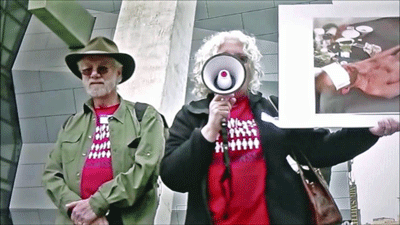
Ron Davis and Janet Dafoe at a Millions Missing rally in San Francisco.
I first became involved in ME advocacy in the spring of 2016, when I showed up at an MEAction Millions Missing rally for chronic fatigue syndrome outside the Dept. of Health and Human Services building in San Francisco. I was there on behalf of my then 27-year-old daughter, who’d been ill for 12 years following a bad case of mononucleosis. I had heard there was going to be a call for more government funding, and I wanted my voice to be heard.
I was given a sign to hold that said volumes about NIH. I learned a lot that day – one of which was that chronic fatigue syndrome had another (and better) name – myalgic encephalomyelitis (ME). It would take me some time to learn how to pronounce that second word – and to understand that ME was not simply another name.
A Critical Statistic Produced
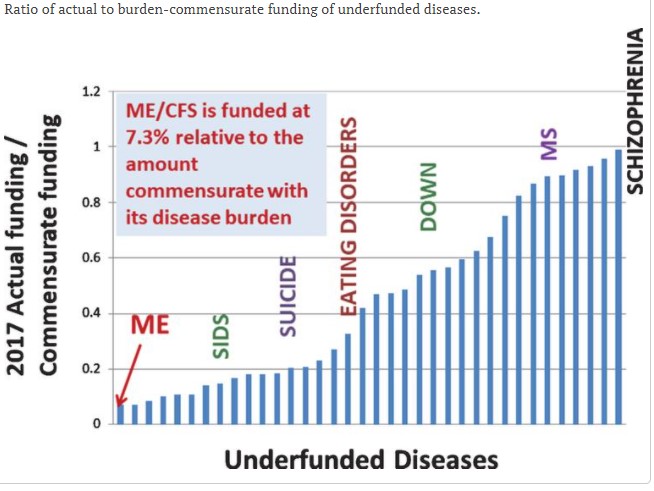
Art Mirin and Lenny Jason co-authored a paper showing that ME/CFS received less NIH funding relative to how much damage it caused than any other disease.
I explained that I was a retired applied mathematician with no background in biology or medicine but was available to help in any way I could. Apparently, my help was needed as I was quickly contacted by Mark Camenzind, who asked if I could do a statistical regression analysis on National Institutes of Health (NIH) funding versus burden, as measured by something called DALY (disability adjusted life years).
I had never heard of DALYs before but learned it was a crucial statistic used to assess the losses that illness cause. It measures years of healthy life lost – either to disability or death. I was surprised, given how much the illness had affected my daughter’s functioning, to find that ME/CFS didn’t have a known DALY value.
I learned that ascertaining the DALY was critical to getting more support for ME/CFS, as DALYs provide an internationally recognized assessment of disease burden. If we could come up with a DALY and demonstrate underfunding, we could use that information to prod the federal government to provide more funding at the NIH. We focused on the NIH because it is far and away the biggest medical research funder in the world.
I teamed up with Leonard Jason, PhD of DePaul University, and Mary Dimmock, a former pharmaceutical executive and a mother of a person with ME/CFS, to produce a DALY for ME/CFS. Our paper, “Estimating the disease burden of ME/CFS in the United States and its relation to research funding”, was published in the Journal of Medicine and Therapeutics in 2016, and was subsequently updated in 2020.
When NIH ME/CFS funding was compared to its disease burden, we found that ME/CFS had the lowest NIH funding relative to disease burden of any disease. In fact, the funding was so low compared to the disease burden ME/CFS incurred that the ME/CFS field would need to incur a 14-fold increase for its funding to be commensurate with (the) burden (it caused.)
Next, I joined a group of advocates in the US Action Working Group and co-led a USAWG project to develop boilerplate language on ME that advocates could easily use to make a difference.
California Actions
I had never met with a legislator before. It was an entirely new experience for me.
Upon attending Science Day in 2017 in Livermore, I showed my representative, Eric Swalwell, the NIH funding versus burden graph which indicated the NIH was dramatically underfunding ME/CFS. He asked if he could keep it. That would be the first of many encounters with Congressman Swalwell.
I had never met with a legislator before. It was an entirely new experience for me. At first I felt a bit anxious about speaking to legislators, but I have now done it so much that it feels routine. I never envisioned proposing legislation either. It was exciting – and frustrating – because there is such an uphill climb with ME/CFS. I had one supportive legislator tell me to my face that they would support my legislation but would not be the chief sponsor.
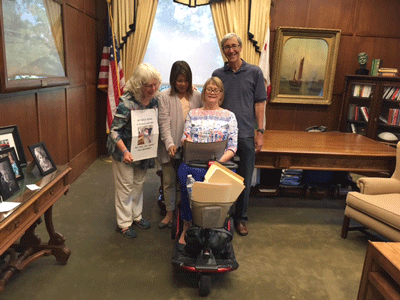
Art, Bobbi Ausubel and Terry Gilmete meet with California legislators.
Working with other advocates has been enriching. I have made friends and comrades. Of course, not everything goes smoothly, and the more you develop a stake in something, the more you develop strong opinions about how things should be done. My whole research career involved a lot of collaboration, oftentimes with strong personalities, so I think I know that territory pretty well.
In the spring of 2017, Bobbi Ausubel solicited volunteers to accompany her to Sacramento to meet with the chief health aide of (then) Lt. Governor Newsom. Our principal goal was to have the California Department of Public Health (CDPH) send a letter to all California physicians informing them about ME/CFS. New York advocates had gotten Commissioner Howard Zucker to send a letter on ME/CFS to all New York physicians. We were hoping to replicate that action in the most populous state in the U.S.
On June 23, I picked up Bobbi at her house in Walnut Creek and we drove to Sacramento to meet another advocate, Terry Gilmete at her Sacramento home. I will never forget, when we were on I-80 around Vacaville, Bobbi (who was a stranger to me) took out an egg and cracked it on my dashboard. (Fortunately, it was hard-boiled.)
Newsom’s aide supported our effort and contacted the CDPH, but next we learned that CDPH does not send out letters. Nor would they meet with us!
We retrenched and solicited the help of another legislator, State Senator Steve Glazer. Glazer had been the chief sponsor of SCR-40, which proclaimed May 12th ME/CFS Awareness Day and May ME/CFS Awareness Month in California. Advocates had used SCR-40 to bring legislators up to date on ME, get their support, and to set the stage for bigger things.
Suddenly, with Senator Glazer on board, the CDPH was happy to meet with us (!) and a meeting was arranged for early December. Bobbi, Terry and I were joined by Lily Chu (IACFS/ME Board member), Dotty Camenzind and Emily Taylor (Solve ME’s chief advocate). We met with representatives from the chronic disease branch of CDPH and from legislative and government affairs. Like many such meetings, the people with whom we were meeting had no real knowledge of ME but were polite and attentive.
One of our simple asks – a real no-brainer, we thought, was to set up a webpage for ME on the CDPH diseases and conditions website. It was in the aftermath of this meeting that I first began to appreciate what we were up against.
In follow-up discussions, I was told by my legislative and government affairs contact that CDPH does what it is funded to do, and what it is legally mandated to do – neither of which applied to putting up a webpage on ME/CFS! If we got funding or legislation passed, however, they would be happy to put up that webpage.
“The California ME/CFS Initiative” Is Born
A dogged persistence is clearly an asset in this work!
That winter (2017) I put together a presentation outlining areas of proposed legislation. I was pretty much on my own, as others did not have the time to meaningfully assist. I met with my Assemblyman Bill Quirk – also a former employee of Lawrence Livermore Lab (and a former climate researcher) – so we hit it off pretty well. I also met with aides to several other legislators who played a critical role in helping me put together a major legislative proposal.
By the spring “The California ME/CFS Initiative” was ready. Senator Glazer’s district director was very supportive and said she would pursue legislation.
Meanwhile, I met with and informed Dr. Jose Montoya of Stanford about advocacy efforts underway in California and other states (NY, MA), and this ultimately led to a meeting with the CDPH director.

Persistence is a virtue in advocacy.
Within the next 9 months, though, Dr. Montoya would leave Stanford, the CDPH director would leave CDPH, and a key legislative aide would move on. Such is the way, I learned, of advocacy at times: you can strike up relationships, make progress, only to have to start it all over again. A dogged persistence is clearly an asset in this work!
During the 2018 timeframe, I was contacted by Beverly Weiss of Pasadena, who was engaged in her own legislative efforts in SoCal. Beverly and I agreed to work together to make the California ME/CFS Initiative happen. In doing so we would ultimately meet with (or facilitate other advocates meeting with) nearly 30 state legislative offices.
When the legislation deadline of 22 February 2019 passed, we retooled for the next year. A key need was finding a chief sponsor for the legislation. While we were able to find people willing to co-sponsor the “The California ME/CFS Initiative”, finding that crucial chief sponsor who would lead the action was not proving easy.
Our initial legislative attempt had focused on easy, inexpensive actions, with our big ask – Centers of Excellence – to come later, but this time we decided to put Centers of Excellence front and center, as the earliest legislation could pass would be 2020, with money not flowing until FY21. We decided to request a one-time allocation of $15M, to be spent over 3 years, to form a statewide ME Centers of Excellence program.
Although that was not a tiny amount of money, it was not that large either given California’s budget surplus. Moreover, the State had just allocated that amount for Sickle Cell Disease Treatment Centers. I was encouraged by a legislative aide to formulate legislative language based on the Sickle Cell bill (which I did). However, the 21 February 2020 deadline came and went. About a month later, the pandemic hit.
University of California Actions
In parallel with our legislative activity, we began an effort, initiated and largely organized by Beverly, to reach out to the University of California (UC) as well. Over the course of 2019, we organized public comments at 2 meetings of the full Regents and 3 meetings of the Health Services Committee.
Our primary aim was to interest UC in treating people with ME, and to include ME in their medical school curriculum. With the facilitation of the Health Services Committee chair, we met with a UCLA vice chancellor who acted as a liaison to all of the UC medical campuses, along with several UC physicians. One of those physicians has since developed an interest in working with ME patients and attended both the IACFS/ME and MEAction seminars on ME and long COVID (2020).
MEAction’s California State Chapter
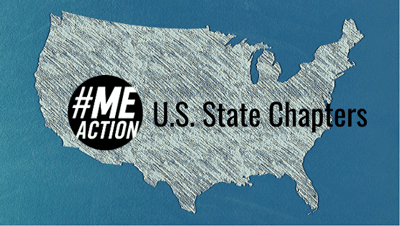
Check out MEAction’s State Chapters.
Back in 2019, MEAction had announced the formation of State chapters. Beverly and I volunteered to co-lead advocacy efforts for the California chapter. This past summer (2020) I took over for Laurie Jones as leader of the MEAction CA state chapter.
One of my primary goals has been to increase attendance at our monthly calls by providing an atmosphere of support and working with leaders of the other 9 State chapters. We currently have a Google group consisting of over 100 members. Our monthly calls have averaged between 15 and 25 attendees.
One of the state group’s ongoing efforts has been to get the California Medical Association to pass a resolution supporting educating physicians about ME. The proposed resolution – led by Dotty Camenzind – was endorsed by the Alameda Contra Costa Medical Association and is still under consideration by the California Medical Association.
This past July several of us met (remotely) with the California Surgeon General’s office, who deals primarily with Adverse Childhood Experiences. We provided possible material for their website, which they are currently evaluating.
- Check out what MEAction’s State Groups are up to and join or start one in your state.
The Coronavirus Pandemic
The pandemic has had a dual effect on ME advocacy. Legislators and State agencies are oversubscribed dealing with COVID. However, the potential of ME onset due to COVID has become a real concern as well. It seems like every day there is a media article on COVID long-haulers (also known as long COVID, and more formally Post-Acute COVID-19 Syndrome (PACS)), and many of those articles mention ME. The US ME/CFS Clinician Coalition recently published an article estimating an ME/CFS onset rate of 10% among COVID sufferers. Such an onset rate would result in a tripling of the pre-pandemic US ME/CFS prevalence.
That makes it now more urgent than ever that health care providers be familiar with the diagnosis and treatment of ME and that this knowledge be applied when treating long COVID patients – particularly regarding the risks of prescribing graded exercise therapy.
We are currently advocating for the State (mainly the public health department and medical board) to proactively reach out to all California physicians, nurses, and other health care professionals and update them about ME/CFS and its connection with long COVID.
That would include: (1) directly contacting them, (2) posting information on health department and other relevant websites, and (3) promoting enrollment in continuing medical education. We believe that these actions can be accomplished within the existing State budget.
In December we met with both the Medical Board of CA and the CA Dept of Public Health (CDPH) with the result that the Medical Board agreed to publish an article in its Spring Newsletter on ME/CFS and long COVID. I just helped prepare a draft of that article.

Art and the California ME Action state group have launched a statewide campaign to educate legislators on ME/CFS and long COVID
We also offered to work with CDPH to create an ME website for their Diseases and Conditions page and recently supplied them with a draft webpage. We would also want them to cross-reference it with their COVID information and publicize among CA health care entities. We are cautiously optimistic that they will go ahead, but they did warn us that their plate was full with vaccine distribution and other COVID issues and that it would likely take a while.
We (MEAction) have also been working in concert with Dr. Jennifer Curtin of Mtn View, who has actively participated in our interactions with State agencies. We have recently launched a statewide campaign to educate legislators on ME/CFS and long COVID and have requested them to sign a letter urging CDPH to move forward with the aforementioned website (so far 3 have agreed).
We also contacted the University of California to inform them of the connection between ME/CFS and long COVID. This led to our meeting with physicians from several of the UC campuses this past April. We are continuing to interact both with these physicians and with UC administrative personnel.
I have written a new Centers of Excellence proposal that ties into long COVID. It most likely will have been released by the time you are reading this article.
Federal Actions
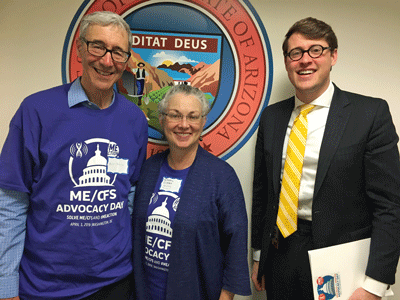
In 2019, Art traveled to Washington DC where he met with the offices of 8 legislators during Advocacy Day.
While the focus of MEAction California has been on state actions, in particular the efforts with State agencies, the legislature and UC, there have been ongoing federal activities as well. I have been working closely with Ben Hsuborger and others addressing issues involving CDC and NIH and contribute to strategy discussions and document preparation. I recently took part in a phone call between MEAction and CDC. Current items of concern include the failure of the Interagency Working Group to address ME/CFS in an effective manner, and promoting the meaningful inclusion of ME/CFS in the $1.15 billion PASC Initiative.
I also took part in this year’s ME and long COVID Alliance Advocacy Day, having met with 8 legislators. I took part in last year’s Advocacy Day as well, and the year before went to DC to advocate in person.
Other Activities
I recently co-authored a journal article on accommodations for university students with ME/CFS. We prepared a follow-on Guide that is available through MEAction here. We are trying to promote this Guide with several universities and a national organization.
Noting the frequency with which ME/CFS advocates and others cite the prevalence and economic cost figures in the 2015 NAM report, and the fact that those figures are based on very old information, I joined with Lenny Jason to publish updated figures taking into account increases in population and economic cost and inclusion of children. In particular, based on the methodology of the NAM report, we estimate the annual US economic burden to be $36-51B and the low-end US prevalence to be 1.5M people.
In my work on NIH funding, versus disease burden which demonstrated the severe underfunding of ME/CFS, I noticed that several diseases that affect primarily women were severely underfunded as well. This led me to perform a study of NIH funding versus gender prevalence, culminating in a recent publication in the Journal of Women’s Health: “Gender Disparity in the Funding of Diseases by the U.S. National Institutes of Health“.
A mathematician working on state-of-the-art climatological computer modeling, Art hardly seemed like the kind of person to get bitten by the advocacy bug. The opportunity to make a difference for his daughter and others with this disease, however, pushed him forward to take on things he’d never taken on before. The good news is that it worked! Not only has he helped others but his life has become enlarged in ways he’d never expected. People like Art Mirin and Mary Dimmock show how valuable the able-bodied, in particular, can be in our fight for funding and recognition.
Find out how you can make a difference and enlarge your life as well. MEAction provides a multitude of ways to make an impact, and the Solve ME Initiative is focused on the critically important legislative front in the U.S.






Art, You are a treasure. Thank you for your persistent and competent work on behalf of ME/CFS (and Long Covid) patients in CA and everywhere. Your contributions in calculating disease burden (with Mary Dimmock) are among the most valuable volunteer contributions in our field. Here’s hoping the tragic addition of Long Covid sufferers to our community finally jars our country and our health care worlds into action.
Huge kudos to you, Art! You really did a good job of portraying the ‘back side’ of lobbying. I especially appreciated that much of your article dealt with entities in California–which is where I live. Bless you and thank you!
Art, you are more than a treasure and I am forever thankful for being able to advocate with you.
Thank you thank you thank you……..
God bless all of you fighting for us. I’m more encouraged more then ever even if it doesn’t happen in my lifetime. 26+ years ago was my onset.
Art, I am so grateful for your tireless efforts on behalf of pwME. Thanks for all you do. Your daughter must be so proud of you!
So grateful for all that you and your fellow advocates do. Thank you so much Art.
Thank you Art, for all you have done and will do for ME/CFS. If only every area had someone as committed as you working on all these things, we’d be much further along. So many of us with this illness can’t do much advocacy, much less all the things you’ve participated in, and are dependent upon the able-bodied to do so for all of us. Bless you!
Mr. Davis,
What an effort you have made on behalf of your daughter and the remaining patients who struggle with this brutal illness, moment by moment. Like your daughter, I was struck with mono at the age of 15. I am now 66 years old. When I saw your words, “Measuring Years of Healthy Life Lost” my first thought was, WOW!!! That measurement in my own life is astronomical, as for much of the 51 years I have been bed bound or housebound. Today I don’t feel invisible. Thank You, for that! And thank you for all you are doing!!! Best Wishes for your daughter who shares this diagnosis with we, the ‘Island of Misfit Toys” (That Santa throws out the back of the sleigh to be rid of!) Thank you very much!!
Patte Dotson
51 years sick pfff, almost a lifetime. Me almost 25 years sick now. I wish you the best and all other people who suffer. Take care your a very strong person!
Thank you for everything that you do!
I appreciate your description of the history of your advocacy involvement – it could be used as an advocacy roadmap for all jurisdictions.
And your work on the ME DALYs is invaluable, truly. When I first heard of this, I just thought: yes! Exactly what is needed.
Yes! Exactly what I thought of. Art is a roadmap! The ME Action California state group is a roadmap. The California Initiative is a possible roadmap. 🙂
Wow, wow, wow!! Amazing work.
Art you are incredible.
So this is how the sausage is made!?!??
What I love about this blog is the possibility that Art presents. When Art went to that Millions Missing meeting was there any way that he thought he would be meeting dozens of legislators, creating initiatives, producing journal papers, going to DC? No. Besides the opportunity to make a difference for his daughter and others with ME/CFS, advocacy actually opened up a new and enlivening world for Art. The point is that he had no idea it was out there until he jumped in. As he noted, advocacy can be frustrating, it can take a lot of persistence but it can also be very enlivening.
Art,
How wonderful to see you put down on paper the huge list of commendable actions you have led and been part of creating!!! I am very proud of you. I rely on you regularly, as you know. You are a great asset to advocacy efforts. I am so happy to see you so well appreciated. You deserve it. Best wishes to you and your family.
When can we retire?
Yes, I eat eggs. I have hypoglycemia, which means I need to eat regularly or have low blood sugar and get whoosy. Glad you noticed my egg. They get me moving when Im falling down.
Art, I just got a thought about who you might approach to sponsor a bill for ME/CFS. I have written to California Democratic U.S. Senator Diane Feinstein about more funding and recognition of ME/CFS and actually got a message back that she supports our cause. This was very surprising considering she was the only Congress person who replied to my requests.
Perhaps she might sponsor a bill?
Thanks for being our superhero advocate mathematician Art! Keep up the great work. Now if we can just get more billionaires for fund ME R&D…. Then teach Rotaries, other group and WHO (World Health Organization).
‘A dogged persistence is clearly an asset in this work!’
Well that’s evident in your phenomenal efforts. I find your article so encouraging. You’re advocating, in collaboration with others, in so many really important areas and producing relevant research to back this up. I think it takes a great deal of energy and resilience to accomplish what you’ve managed to achieve Art.
I am so grateful to you as so many others have said. So thankful to you for all the work you have done for a disease that upended my life at age 50. All the comments before mine say all I would want to say to you. At 83 I might be one of the oldest patients. I cannot thank you enough for sharing this with all of us. There are millions who will benefit from all your efforts.
Yea Art! I hope you will save this piece for historians. One day, when ME/CFS is a well-known and well-funded disease (yeah….) people interested in the history of medicine will want to know all of this. It will be right up there with what it took to prove MS was due to demyelination and not psychological, and ulcers were caused by bacteria and not stress! Meanwhile, you and your colleagues in CA are showing the rest of us how it’s done and what it takes. Kudos!
Thanks so much, Art. We are very grateful to you!
I was wandering around the internet looking for information on mast cell disorder when I found the web site for a cardiovascular specialist in New Jersey. His autonomic questionnaire hit on the majority of my current and some past symptoms. https://franklincardiovascular.com/autonomic-questionnaires/
This is the first time anyone has mentioned dimmed hearing, chronic tinnitus and dimmed vision…all problems I have currently.
I am just sharing this in case it may help Art’s daughter.
My daughter and I both have HHV6A. She has the chromosomally integrated version and I had an active case with continued elevation. Our daughter has been helped more than once by Tamiflu. I have been treated with various things including an experimental non-anticoagulent form of heparin from Germany. We both have almost identical symptoms including blood that clots in the tube during a blood draw. I am currently starting a trial of low dose naltrexone with promising results so far. I first got sick in the early 1980’s and I will share that this is an illness of revolving symptoms. For about 15 years, I had horrible migraines. Then one day, they disappeared. I also had reactions against all kinds of chemicals that had never bothered me before. This was helped by the anticoagulent because it is a mast cell stabilizer, but I still have to take tiny doses of medications and can’t be around any pesticides or other chemicals. I hope this information may be helpful to Art and anyone on the list with similar symptoms
One DALY step for ME
One giant leap for humankInd.
YES!!
@Tab
🙂
Thank you for representing us Art Mirin!
Thank you all very much for your supportive comments.
This post is extremely encouraging and I think Art Mirin’s exploring outside the traditional federal government channels is exactly what we need country wide.
I have a great niece with Cystic Fibrosis and it wasn’t the government who moved to meet their needs – it was private parties (especially Bill Gates Sr with a large research grant in the late 1980s) and now the Cystic Fibrosis Foundation has become a major power in the health industry.
I believe those of us suffering with ME/CFS need the same kind of support.
Kudos to Art Mirin and we need 50 Art Mirins, one in every state, also coordinating together, to move things forward. If #MEAction is the group to do it, go #MEAction!
Thank you, Art Mirin, and thank you #MEAction for being the initial force providing him the way to approach it, and thank you Cort, as always, for the reporting.
Thank you so much, Art!